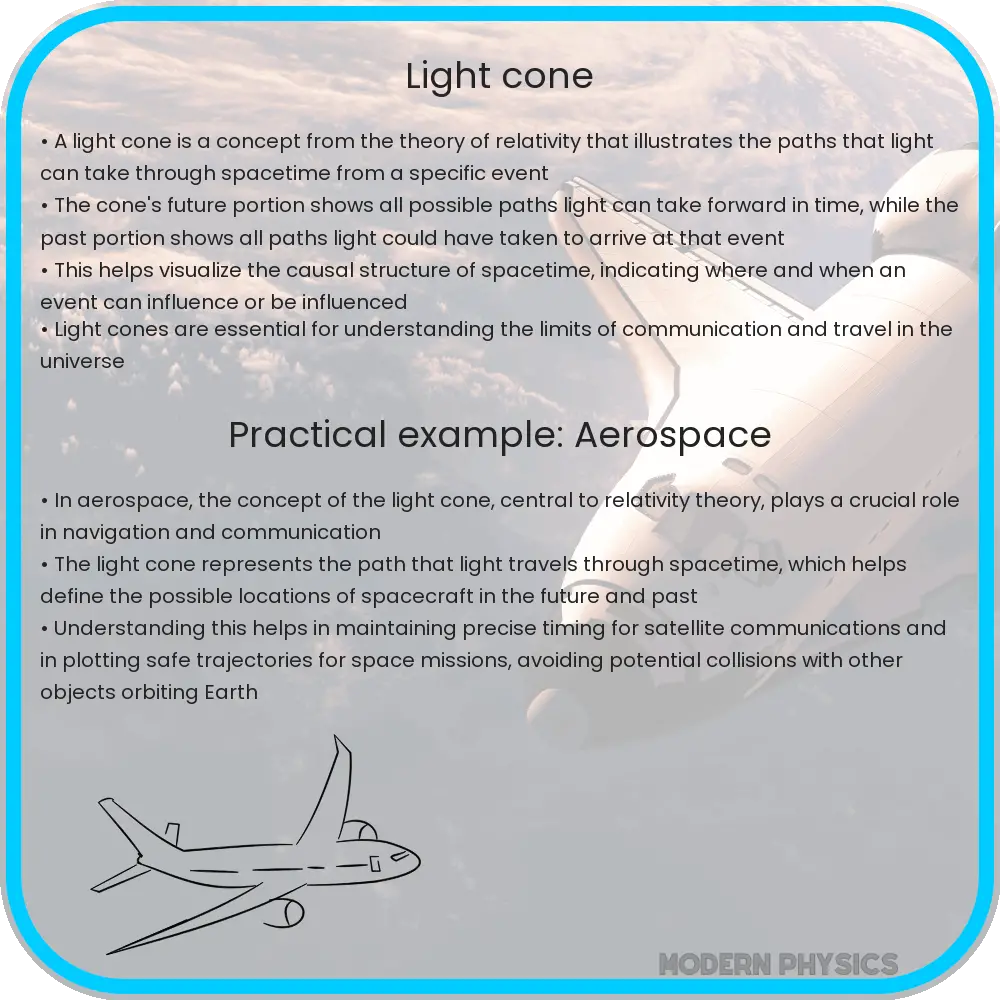Explore the light cone concept in physics, linking spacetime, causality, and signal propagation, and its role in understanding the universe.

Understanding the Light Cone: A Gateway to Spacetime and Causality
The concept of a light cone is fundamental in understanding the intricate relationship between spacetime, causality, and the propagation of signals in the universe. This concept, rooted in Albert Einstein’s theory of relativity, provides a powerful tool for visualizing how different events are interconnected within the fabric of spacetime.
Spacetime and the Fabric of the Universe
At the heart of the light cone concept lies the notion of spacetime, a four-dimensional continuum blending the three dimensions of space with the dimension of time. This fusion of space and time into a single entity was one of Einstein’s revolutionary contributions to physics, challenging the conventional, separate views of space and time prevalent before the 20th century.
In spacetime, an event’s position and time are not independent but are interwoven. This relationship can be visualized through a spacetime diagram, where time typically is represented vertically and space horizontally. Such diagrams help us visualize how events unfold in the universe.
The Light Cone: Visualizing Causality
A light cone is a specific type of spacetime diagram. It represents all possible paths that light could take to reach or emanate from a specific event. This cone comprises two parts: the future light cone and the past light cone. The future light cone contains all the points in spacetime that can be affected by an event, while the past light cone encompasses all the points that can influence the event.
This structure is pivotal in understanding causality – the relationship between causes and effects in the universe. In simple terms, causality dictates that an effect cannot precede its cause. In the context of the light cone, this means no signal or causal influence can travel faster than light, ensuring that cause and effect remain in their respective light cones.
Signals, Speed of Light, and Relativity
The universal speed limit set by the speed of light is a cornerstone of Einstein’s theory of relativity. This limit is not just a characteristic of light but a fundamental property of the universe, governing the speed at which information and influence can propagate. Within the framework of the light cone, this principle implies that any signal or causal effect must remain within the light cone’s bounds, never exceeding the speed of light.
This constraint has profound implications for the nature of information transfer and the interconnectedness of events in spacetime. Understanding the light cone helps us grasp the limitations and possibilities of signal transmission across the cosmos, laying the groundwork for exploring more complex concepts in physics and cosmology.
Is this conversation helpful so far?
Implications of the Light Cone in Modern Physics
The light cone model not only serves as a foundational concept in theoretical physics but also has practical implications in various fields. In astrophysics, it aids in understanding the observable universe’s limits. The observable universe is essentially the interior of our past light cone, encompassing all events from which light or signals have had time to reach us since the Big Bang.
In quantum mechanics, the light cone concept helps delineate quantum entanglement’s peculiarities. Entanglement, a phenomenon where particles remain connected so that the state of one affects the other, must still respect the light cone’s boundaries, ensuring that no information is transmitted faster than light.
Light Cone in Cosmology and Black Holes
In cosmology, light cones play a crucial role in understanding the universe’s expansion and the nature of black holes. The event horizon of a black hole, for instance, represents a boundary where the light cone is so drastically altered that all paths lead inward, with no possibility of escaping the black hole’s gravitational pull.
The expansion of the universe can also be understood through light cones. As the universe expands, distant galaxies move away from us, altering the shape of our future light cone and consequently the portion of the universe we can affect or be affected by.
Challenges and Future Perspectives
While the light cone model provides significant insights, it also presents challenges, especially in reconciling general relativity with quantum mechanics. Theoretical frameworks like string theory and loop quantum gravity attempt to merge these domains, and understanding how light cones operate within these frameworks is an ongoing area of research.
Conclusion
The concept of the light cone is more than a mere theoretical tool; it’s a lens through which we view and understand the universe. It elegantly combines the realms of spacetime, causality, and the speed of light, offering profound insights into the nature of the universe. As we continue to explore the cosmos and delve deeper into the mysteries of physics, the light cone remains a crucial concept, guiding our understanding of the fundamental principles that govern everything from the smallest particles to the vastness of the cosmos.
In summary, the light cone is not just a cornerstone of modern physics; it is a testament to our evolving understanding of the universe, a symbol of the intricate and beautiful tapestry that is our reality.
